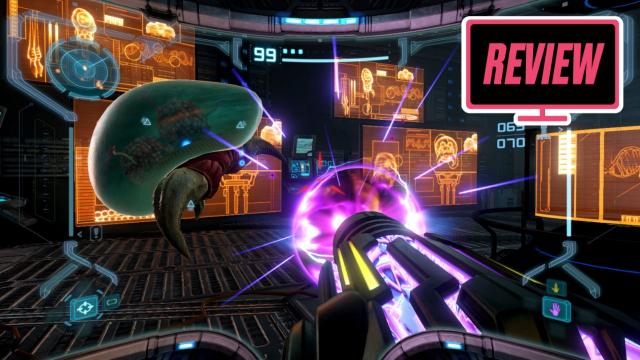The first three hours of Metroid Prime Remastered are a bit like enjoying a cool drink in a desert. It’s a game that reminds you why you give a damn about this medium in the first place. It is an intricate masterpiece created by a team figuring it out as it went, a Faberge egg created with a blacksmith’s hammer. And at a whopping 20 years old, the remastered Metroid Prime is still a pleasure to play.
Metroid Prime Remastered sits in the series timeline between the events of the original Metroid on the NES and its sequel, Metroid II: Return of Samus on the Game Boy. After intercepting a distress signal from a frigate called the Orpheon, Samus Aran arrives on a ship full of murdered Space Pirates. Slain by the genetically mutated creatures the pirates had been holding captive, Samus runs through a level designed as a nod to Super Metroid‘s famous opening. The ship is explored. A small amount of combat is entered into. A short-and-sweet boss fight erupts, followed by a self-destruct signal. Samus must then escape the ship as a countdown to its detonation ticks down on-screen.
From there, she chases arch-nemesis Ridley down to the nearby planet of Tallon IV, the Chozo homeworld. 50 years ago, the last of the Chozo died out, the result of something they called “The Great Poison,” the by-product of a meteor strike many years before. The Space Pirates have since moved in, turning Tallon IV into a base of operations. They’ve come to call this poisonous, mutagenic substance ‘Phazon’ and are attempting to harness it. It’s up to Samus to put a stop to their operations, uncover the secret of the Phazon meteorite, and save the galaxy again.
All in a day’s work for a big orange bounty hunter from Zebes.
Even at the time of its launch, the move from the series’ traditional 2D, sidescrolling perspective made waves. Nintendo was quick to state that Metroid Prime was a “first-person adventure” game, not a first-person shooter. They caught a bit of heat for it at the time, but I think the descriptor was apt then and remains so now. Shooting is not the game’s active focus, it’s just one verb among many. Samus’ arm cannon is the sci-fi equivalent of a Swiss army knife, a multipurpose zap machine that the bounty hunter relies on for almost everything. This notion was reinforced in the Gamecube original, which required players to stand still if they wanted to use the more accurate targeting or scanning reticules. Now, with the new Dual Stick control layout, the reticule stays. You can simply look around with the right stick and aim at what you like with ease while staying on the move. Other control schemes included in this package recreate the Wii’s motion control layout from the Metroid Prime Trilogy, the classic Gamecube inputs, or a hybrid of the two.
Upgrades to the game’s visuals have been applied with a gentle touch. Textures and models evoke the Gamecube original while making subtle alterations. Some are obvious — all the doors look very different now, though most basic wall textures appear to have been given a simple up-res. Others are quite subtle — Samus’ razor-thin eyebrows, though fashionable in 2022, have been replaced by more contemporary styling. The aspect ratio has been upgraded from the Gamecube’s native 4:3, optimised for CRT televisions, to 16:9 for modern panels.
Yes, it may surprise you because Metroid Prime still feels so fresh in my memory, but it is actually so old that we played it on CRTs. I can feel my ancient bones crumbling into dust as I write this.
What surprises me is that, with only the lightest of changes, Metroid Prime Remastered is still so very playable. That it hasn’t changed all that much from the 2002 original speaks to the strength of its core design. There’s a timelessness to it — everything that worked then works now, something that can’t be said for every title the Gamecube ever produced. My first two hours, spent delving into Tallon IV’s twisting corridors and uncovering its secrets, were a balm. The drip feed of items, stripped on your arrival to Tallon IV, returned to you at a perfect pace. The little details you forgot about, like rain sprinkling on the visor when you turn your face to the sky. The way the level design folds back in on itself as upgrades are added, always in a way that is recognisably Metroid while translating perfectly to the first-person perspective.
Metroid Prime Remastered is a beautiful, low-touch remaster of a game that has stood the test of time. Unplayable on modern hardware since the Wii, it is a thrill to have it available to new audiences in 2023. That it comes only weeks after GoldenEye, another vanished titan in Nintendo’s storied title, finding its way home at last is doubly wild. I’ve been sent hurtling back in time to 2003, and life is good.
Playing Metroid Prime in 2023 helped me draw a line between it and The Legend of Zelda: Breath of the Wild. They share a certain spirit, a willingness to take the old traditions ingrained in either franchise and view them through a new lens. They both took risks, broke with convention, and they’ve become defining, timeless entries in both series. When Nintendo takes a punt, it tends to go straight to the hall of fame. Well, most of the time anyway.
Now if we could just get Nintendo to give us an update on Metroid Prime 4.

Leave a Reply